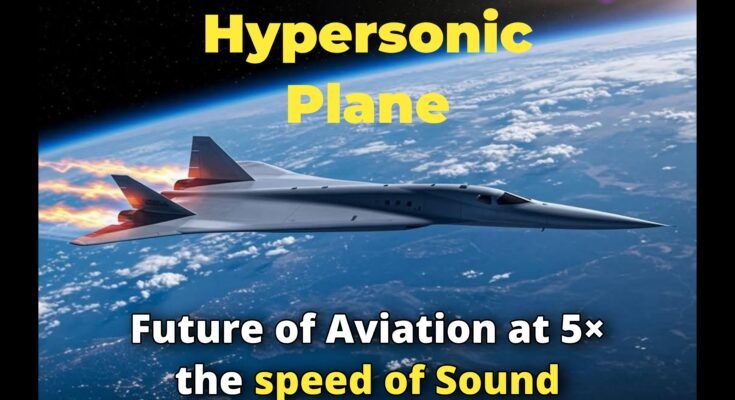In the ever-evolving world of aviation, the idea of traveling at five times the speed of sound is no longer science fiction. The hypersonic plane—a marvel that promises to revolutionize the way we travel—is quickly becoming a reality. With major players like NASA, SpaceX, and private aerospace firms investing in hypersonic technology, the race is on to create a plane that could fly from New York to Tokyo in under two hours.
As the world becomes increasingly interconnected, faster, safer, and more efficient transportation is vital. In this article, we’ll explore the latest developments surrounding the hypersonic plane, its benefits, challenges, and how this next-gen aviation innovation could change the world forever.
Hypersonic Plane: What Does Hypersonic Really Mean?
A hypersonic plane is an aircraft capable of traveling at speeds exceeding Mach 5, or five times the speed of sound (around 3,800 mph or 6,100 km/h). For comparison, commercial jets today cruise at Mach 0.85. These mind-bending speeds mean that intercontinental travel could be reduced from hours to minutes.
History and Development
The concept of hypersonic flight isn’t entirely new. During the Cold War, the U.S. developed the X-15, an experimental aircraft that reached hypersonic speeds. However, these early prototypes were primarily military-focused and unsustainable for public or commercial use.
Now, thanks to technological advances in materials science, propulsion systems, and digital modeling, the dream of building a reliable, efficient hypersonic plane for civilians is closer than ever.
Hypersonic Plane: How Does It Work?
The propulsion system is at the heart of the hypersonic revolution. Unlike traditional jet engines, hypersonic planes are expected to use scramjet (Supersonic Combustion Ramjet) engines, which can operate efficiently at extremely high speeds and altitudes.
Scramjet Technology
A scramjet engine compresses incoming air at supersonic speeds before mixing it with fuel and igniting it. This creates massive thrust without the need for moving parts. The lack of turbines also reduces mechanical failure points, making scramjets simpler in theory—but incredibly complex to execute in practice.
Heat and Structural Challenges
Flying at hypersonic speeds generates extreme heat due to air friction. Engineers must use heat-resistant materials such as reinforced carbon-carbon and ceramic matrix composites to ensure the aircraft can survive the intense thermal environment.
Hypersonic Plane: Benefits That Could Transform the World
The development of a working hypersonic plane could offer unprecedented advantages in global connectivity, national security, business travel, and even space access.
Unmatched Speed
The most obvious benefit is speed. A hypersonic flight could shrink travel times significantly. London to Sydney could take just four hours instead of the current 20+. Business travelers, emergency responders, and even cargo transporters would be able to operate on a much faster timeline.
Military and Security Applications
Governments worldwide are interested in hypersonic tech not only for commercial purposes but also for defense. Hypersonic aircraft could serve as high-speed surveillance tools, missile carriers, or rapid deployment vehicles for military assets. However, this also raises concerns about an international arms race.
Hypersonic Plane: Economic Impact and Global Connectivity
One of the most exciting aspects of the hypersonic plane is its potential to reshape the global economy. Just as the steam engine and jet airliner revolutionized trade and travel in previous centuries, hypersonic technology could compress geography and time like never before.
Business Travel Will Be Transformed
In today’s fast-paced world, time is money. CEOs, diplomats, and entrepreneurs often lose days due to intercontinental travel. A hypersonic plane could change that. Imagine attending a morning meeting in London, a lunch conference in Dubai, and being home in New York by dinner. Such mobility would dramatically improve productivity and accelerate deal-making across time zones.
Tourism Will Enter a New Era
High-speed commercial travel could open new tourism possibilities. Remote destinations that are currently hard to reach, like Antarctica or the deep Amazon, might become new hot spots. Tourists would be able to explore faraway lands in a weekend without jet lag or extended vacations.
Hypersonic Plane and Innovation in Airport Infrastructure
The emergence of hypersonic planes will also require major upgrades in airport and air traffic control systems worldwide.
Supersonic Corridors and New Runway Designs
Because these aircraft reach extremely high altitudes and speeds quickly, special takeoff and landing procedures will need to be implemented. New “hypersonic corridors” in the sky may be designated to safely manage the different flight dynamics and keep them separate from conventional airliners.
Integration with Spaceports
Some hypersonic vehicles, especially those with dual-use for space travel, may need to operate out of spaceports instead of standard airports. Countries like the U.S. and UAE are already investing in spaceport infrastructure that could double as launch points for future hypersonic commercial flights.
Hypersonic Plane Safety and Public Perception
Despite the technological marvel, the idea of traveling at five times the speed of sound can be intimidating for the general public.
Educating the Public on Hypersonic Travel
Just like early passengers were wary of jet aircraft in the 1950s, modern travelers may need time and education to trust the hypersonic plane. Transparency around safety tests, noise levels, and environmental effects will help build public confidence.
Building Trust through Testing and Transparency
To ensure public trust, governments and private companies must conduct rigorous tests and openly share findings. Demonstration flights, media coverage, and virtual simulations can also help people understand what flying in a hypersonic plane would be like.
Hypersonic Plane: Environmental Considerations
Every new transportation technology raises concerns about its environmental impact, and the hypersonic plane is no exception.
Fuel Efficiency and Emissions
Hypersonic engines burn fuel at extremely high rates, which could result in greater emissions. However, ongoing research into sustainable fuels and cleaner combustion processes may mitigate these concerns. Hydrogen fuel is one promising alternative being tested for hypersonic applications.
Noise Pollution and Sonic Booms
One of the major hurdles to supersonic and hypersonic travel is the sonic boom—an explosive noise caused when the aircraft breaks the sound barrier. Engineers are working on “low-boom” designs to reduce this effect, allowing overland flights to become viable.
Hypersonic Plane: The Road Ahead for Regulation and Collaboration
Because hypersonic travel would cross multiple airspaces in a matter of minutes, it raises complex geopolitical and regulatory issues.
Setting Global Standards
The hypersonic plane will need unified international standards for operation, safety, and communication. Organizations like ICAO (International Civil Aviation Organization) will likely play a critical role in creating protocols and certifications for hypersonic flight.
Peaceful Use vs Weaponization
Global collaboration is also essential to ensure that hypersonic technology does not escalate into an arms race. Transparency in development, peaceful use agreements, and shared research can help prevent conflict and promote cooperation.
Conclusion: Is the Hypersonic Plane Our Next Big Leap?
The development of the hypersonic plane represents a turning point in aviation history. Though there are challenges ahead—technical, environmental, and regulatory—the potential rewards are enormous. With continued innovation and responsible international collaboration, hypersonic planes could soon make today’s air travel look as outdated as steamships.
From drastically reduced travel times to the opening of new global markets, this technology could redefine human mobility in the 21st century. As we stand on the brink of this revolutionary change, one thing is clear: the age of the hypersonic plane is approaching faster than anyone imagined.




